Christmas Ale Chutney
This post contains affiliate links. Please read my disclosures.
This Christmas Ale Chutney is a rich sweet malty fruity chutney which tastes delicious over the festive season. It’s sweet, tart and spiced and an ideal accompaniment to cold meats and cheeses. It makes about 8 small jars so you have enough to enjoy yourself and also to gift to friends and family.
I have been making a version of this Ale Chutney for years and used to sell it at local farmers’ markets where it was incredibly popular, particularly around the festive period.
It’s easy to make and doesn’t lean too heavily in Christmas flavour so that it tastes out of place if you have a couple of jars left into Easter. It’s a simple base of rich soft dates and prunes, tang from sharp apples which contrast beautifully with the malty bitterness of your favourite ale.
This recipe (since my website is gluten-free) gives advice on which gluten-free ale is best to buy. However, this advice is just as useful if you are not gluten-free as it runs through the different types of ale and how they can complement the flavours in your chutney in different ways.
We’ll dig deep into the ingredients in this chutney, how they are perfectly balanced for flavour and safe storage. We’ll go through every single process so you understand why you have to sterilise your jars, the best way to store your chutney and how you can serve it.
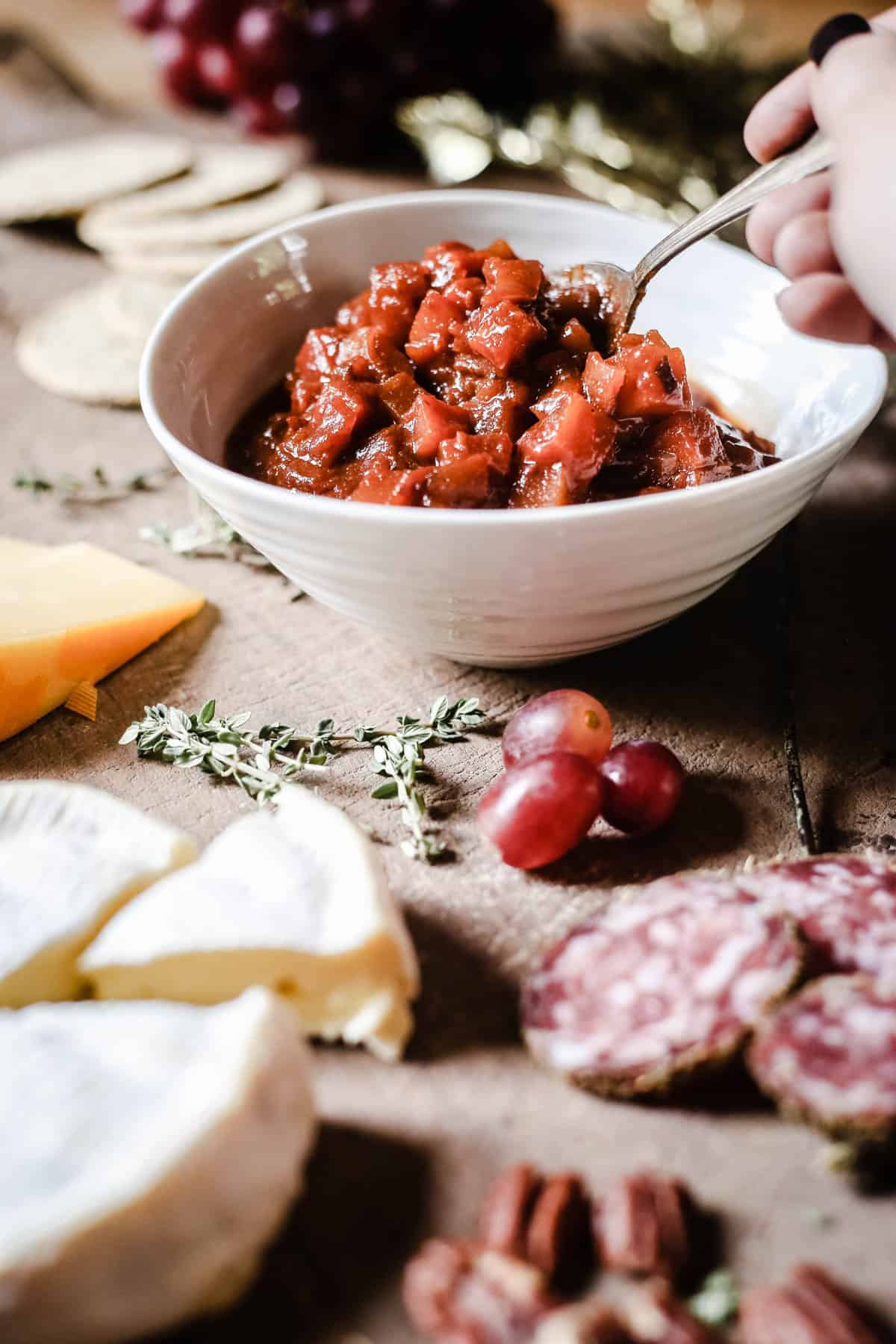
Why You’ll Love This Christmas Ale Chutney
- Flavour. You have lots of spice and rich Christmas flavours which pair beautifully with any cold cuts or cheeses. Round earthy sweetness from the vegetables, tang from the vinegar and sharp apples, malty complexity and festive warmth from the ale and black treacle and a deep rich sweetness from the prunes and dates.
- Simple to make. You might spend a little time chopping the vegetables but really it’s incredibly straightforward and only takes 90 minutes cooking time without any complex methods.
- Gifting. This recipe makes about 8 jars which is perfect for keeping half for yourself for enjoying over the festive period and half for gifting to very lucky loved ones.
Why Use Ale in Chutney?
Ale adds a bit of festive flair to this recipe and we’re using it in our chutney mainly for flavour. It adds a little bitterness and depending on which brand you use a little maltiness. Different brands of ale will impart different flavours.
What’s the Best Gluten-Free Ale to Use?
There are plenty of gluten-free ales around of all kinds of different flavour notes. Use the ale that you like to drink. I enjoyed a lovely taste test during the development of this recipe and if you are based in the UK then the Chiltern Brewery have an amazing selection of different gluten-free ales. I recommend using an ale which has a good malty depth, a touch of fruitiness and rich nutty flavour. Ultimately go with what you like.
Bitter. I like Chiltern Brewery’s Beechwood Best Bitter (which actually isn’t too bitter and has a beautiful toffee-like fruitiness).
Dark Ale. I like Chiltern Brewery’s Three Hundreds Dark Old Ale which has a good malty choice which stands up to the strong flavours in this chutney.
Pale Ale. This is the most common gluten-free ale found in UK supermarkets. BrewDog Gluten-Free Punk IPA or Peroni are versatile choices, although they lack the depth of the stronger ales.
If you are choosing a gluten-free ale from the supermarket then look out for Gluten-Free Old Speckled Hen which has a rich malty fruity aroma which goes well with the flavours in this chutney.
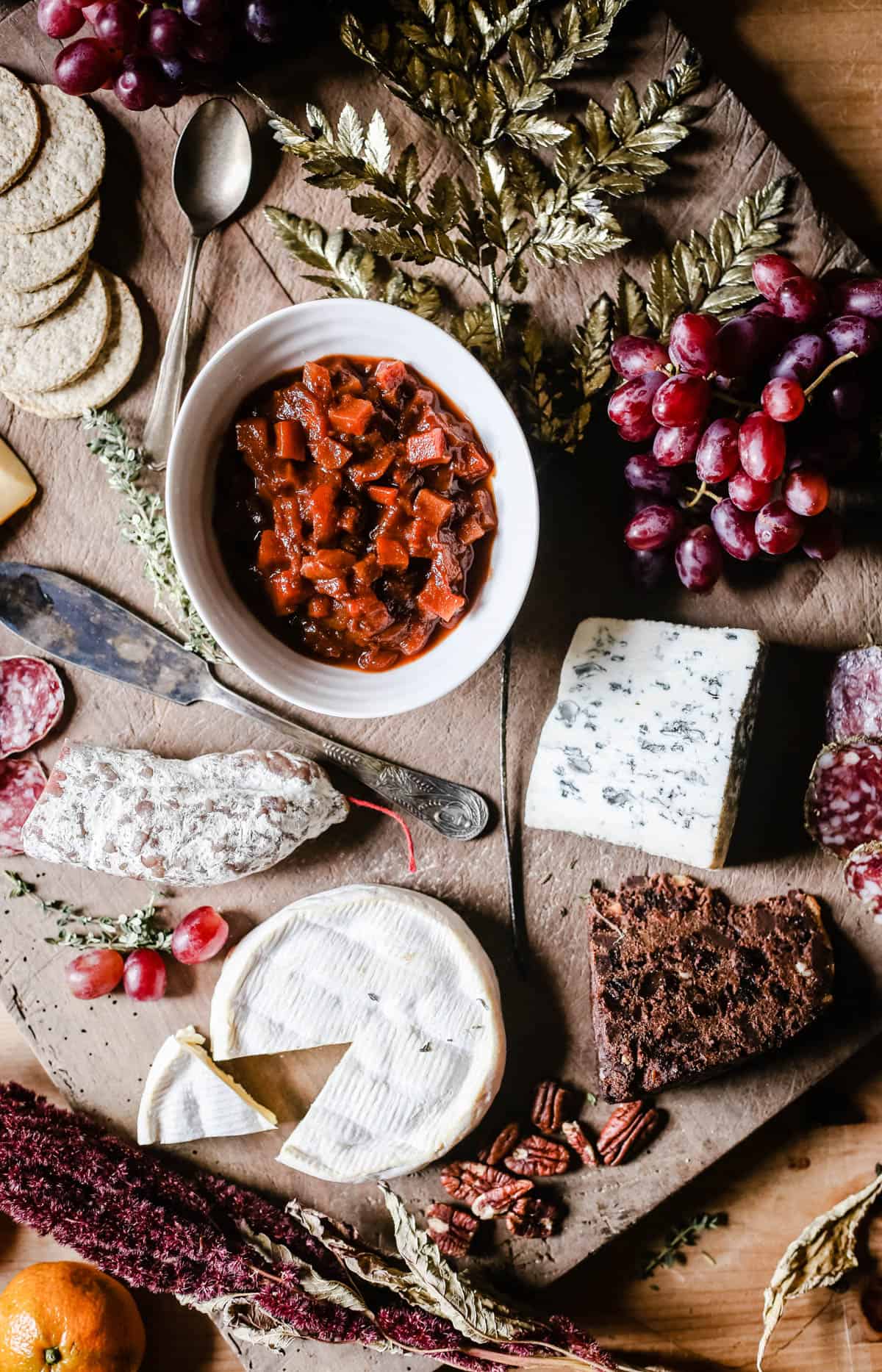
Ingredients Needed
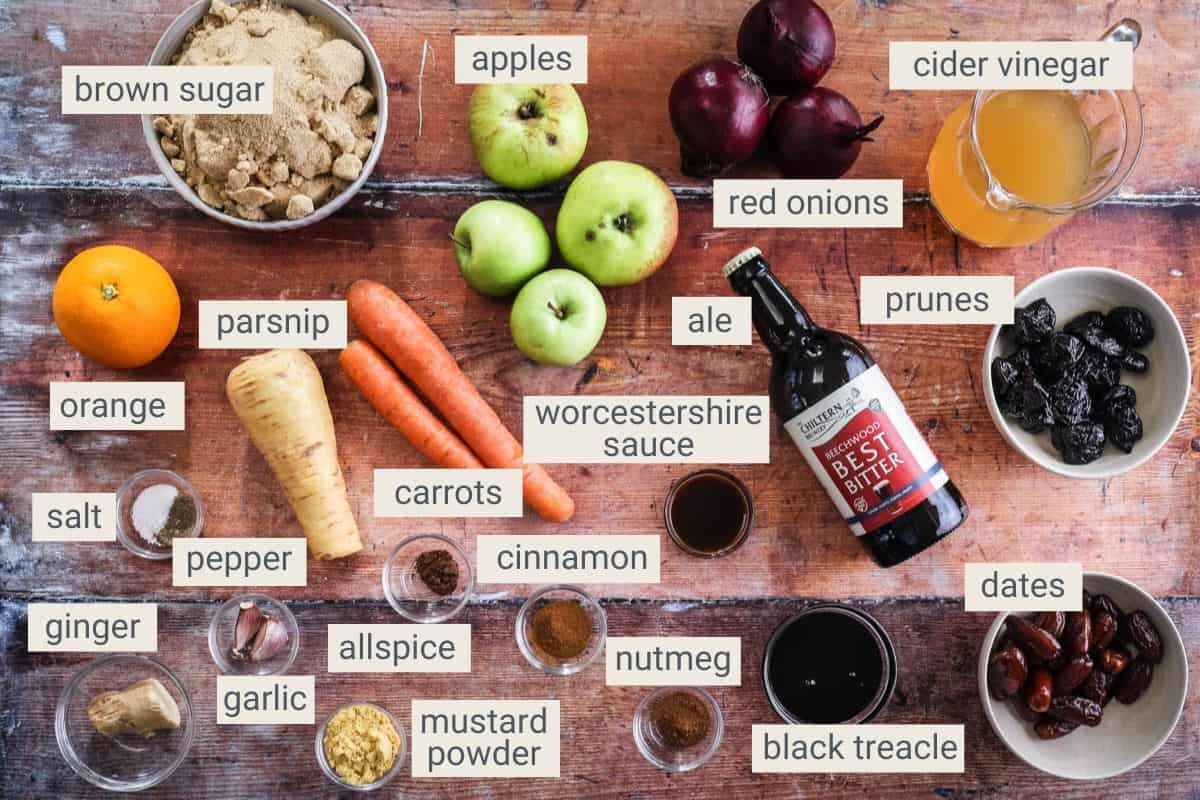
Apples. I recommend using a mix of a good crisp eating apple and cooking apples. Bramley apples and Granny Smiths are perfect. You don’t want anything too sweet as we’ve already got a lot of sweetness going on from the sugar and dried fruits. A cooking apple like Bramley is sharp in flavour and breaks down into a soft smooth body so it’s great for the texture of the chutney. You can swap for any cooking apple. The Granny Smith also has a good tang but keeps its body a bit more so adds a slight bite in the finished chutney.
Red onions. These are a bit more festive than white onions and add a little more sweetness but you can swap with white onions if you like.
Vegetables. This chutney has great body from root vegetables. I like to use a mix of carrots and parsnips. Carrots have a sweetness and good bite plus they are a high acid vegetable so they preserve very well. Parsnips add sweet nutty flavour but don’t be tempted to add more parsnips than the recipe suggests as the flavour can dominate plus they are a low-acid vegetable so you might need to adjust the vinegar and sugar quantities to keep to safe standards.
Dried fruit. This recipe uses prunes and dates which cook down really nicely to form a good soft base to the chutney whilst also adding good sweet flavour. I usually use medjool dates but I couldn’t find any locally when I was taking photos of the recipe and actually the Deglet Noor dates I used worked very well too although they are firmer and less sticky. Ultimately make sure the prunes and dates you use are from a freshly opened packet and still soft and sticky.
Light soft brown sugar. You could swap for granulated sugar or even dark brown sugar. However, light brown sugar is a lovely mix of the two with a slight molasses flavour, perfect with all the rich flavours.
Black treacle. This is a traditional British ingredient and is a dark bitter syrup derived from sugar refining. It has a very unique flavour which beds down nicely with the malty flavour of the ale. However, if you can’t get hold of it then you can substitute for molasses.
Apple cider vinegar. You need a vinegar with at least 5% acidity to ensure safe storage. Apple cider vinegar works well with its mellow flavour. You could swap with malt vinegar (this is only if gluten-free is not a requirement for you as malt is not suitable for gluten-free diets). You don’t need a fancy apple cider vinegar, regular cider vinegar is fine.
Garlic and ginger. Use plump and fresh garlic and ginger for the best flavour.
Mustard powder. English mustard powder is lovely and strong, if you like your chutney to have a kick then you can use 1½ tablespoons. You could swap for mustard but check labels as some mustards are not gluten-free compliant.
Worcester/shire sauce. It adds a lovely base of flavour. However, you need to be careful if you are following a gluten-free or vegan diet as the popular Lea & Perrins brand is not compliant with either. I like to use Biona Organic Vegan Worcester Sauce which has a lovely flavour.
Orange zest. Make sure your fruit is unwaxed so you keep the zest nice and fresh. It gives a little bit more Christmas flavour.
Spice. The deep rich and warming triumvirate of nutmeg, cinnamon and allspice add that signature Christmassy flavour. You can add ½ teaspoon of ground cloves if you really want to accentuate the festivities but sometimes I feel that can be a bit on the nose.
Salt and pepper. I use kosher salt which has a good flavour balance and pre-ground black pepper as that makes it easy for measuring.
Ale. This is a gluten-free chutney so check your labels. You can purchase gluten-free ales in most larger supermarkets and they are usually available in the gluten-free aisles. You won’t have a huge amount of choice in the supermarket (although they are perfectly fine to use). If you wanted an ale with a good rich flavour then look for specialist brands (see guide above).
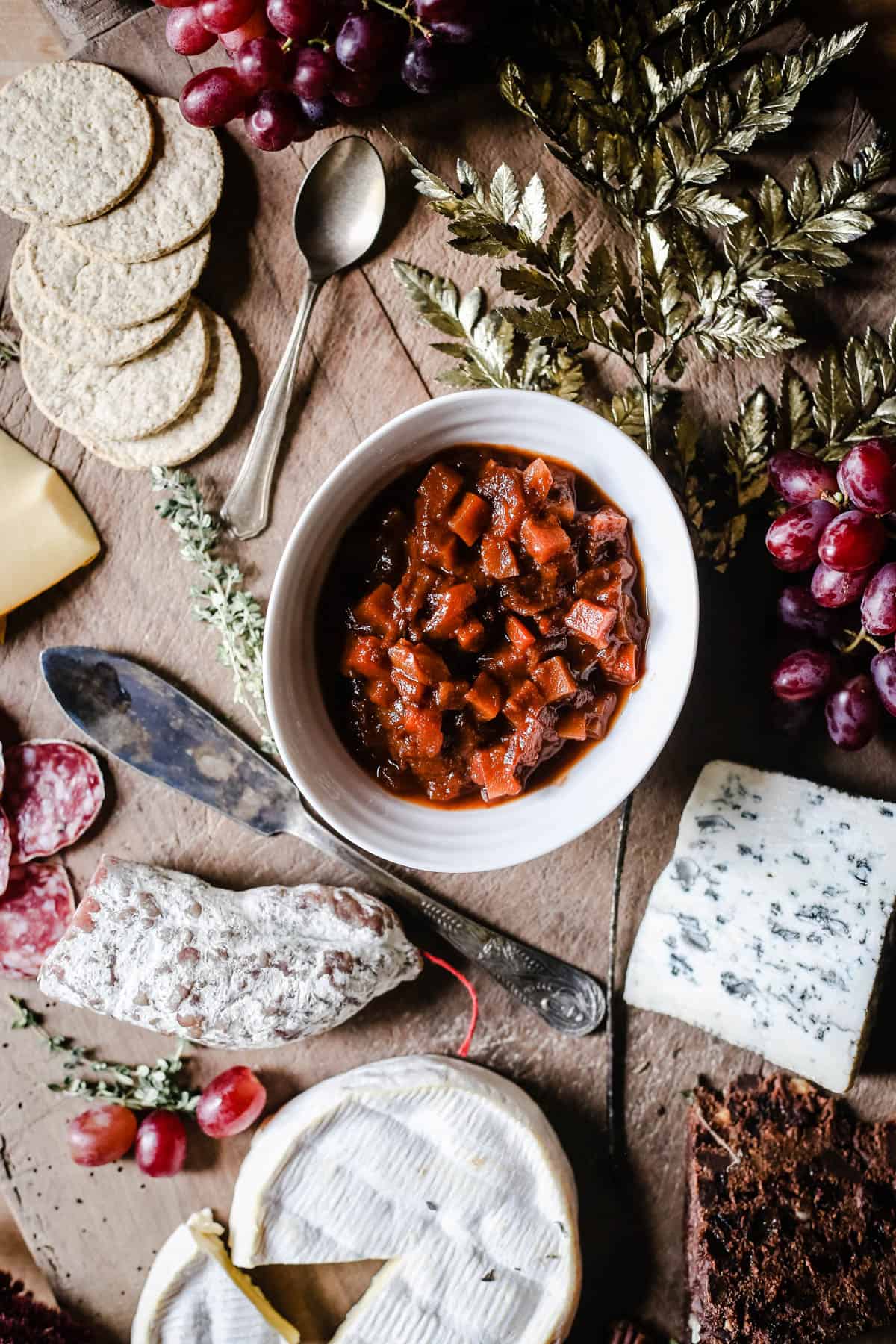
How To Make Christmas Ale Chutney
The following gives a short concise method with step-by-step images.
Peel and chop the fruit and vegetables into even 1.5cm sized cubes, always end with the apples so they don’t brown before you start making the chutney. Put all ingredients into a large preserving pot with 150g water and half the ale.

Bring to a gentle simmer, stirring occasionally, and cook for an hour. Pour in the rest of the ale. Return the chutney to the heat and cook for a further 30 minutes.

Sterilise clean jars in the oven and new lids in boiling water.

Remove the chutney from the heat and decant into sterilised jars. Store in a cool dark place until ready to serve. Once the jars are opened the chutney should be kept refrigerated.

Expert Tips
Ingredients
Peel and chop the vegetables into small uniform pieces so they cook evenly and so they are not too chunky as then they work much better in sandwiches. Always finish by chopping the apples so they don’t have a chance to brown (oxidise) before beginning the recipe.
Cut out any bruised parts to your vegetables. You need them to be fresh and firm to create the best chutney.
Don’t be tempted to mess around the quantities of the ingredients as they have been carefully worked out so that they meet safety standards in a chutney. You need to keep between 60-65% fruit + veg, 30-35% sugar and 15-20% vinegar.
The chutney is ready when it has cooked down to a thick consistency with low liquid.
Sterilising jars & lids
Always used sterilised jars and lids so you can ensure safe storage. You don’t want to mess with bacteria production. Your jars can be ones that have been used before, provided they have been spotlessly cleaned. However, I recommend always using new lids which you can buy in packs online. Lids have a tendency to spoil even after one usage so new fresh lids will ensure safe storage.
The foolproof way to sterilise your jars is to place them in an oven pre-heated to 160°C / 140°C fan assisted / gas mark 3 / 320°F for 20 minutes.
Sterilise your lids a different way. Place them in a saucepan of boiling water with a splash of vinegar (which ensures the lids don’t discolour) for 10 minutes. Don’t sterilise in the oven as they can warp.
Hot-fill, sealing and cooling
The jars should be fresh out of the oven and still hot when you decant the hot chutney into them. This helps to prevent cracking and ensures a tight safe seal on the lids.
Fill the jars to about 1 cm (½ inch) from the top. Wipe the rims with a damp clean cloth then seal with the sterilised lids.
Once you’ve filled the jars then allow them to cool on a cooling rack, a wooden board, on top of tea towels so the hot jars don’t damage your work surface and the cool work surface doesn’t cause a cool shock to the jars which could make them crack.
Allow them to cool slowly undisturbed at room temperature for between 12-24 hours.
Labelling
When the jars are cooled make sure to label straightaway (with the date!) then store in a cool dark and dry place.
If you are gifting this chutney, make sure you include a full label with the title of the chutney, the ingredients, the date it was made, the best before and highlight any allergens. Sounds excessive but it’s well worth the trouble.
Shelf life
This chutney tastes great straightaway but even better after about 2 weeks.
Store your chutney in a cool dark and dry place for up to 12 months.
Opened jars of chutney should be kept in the refrigerator and consumed within 2 weeks.
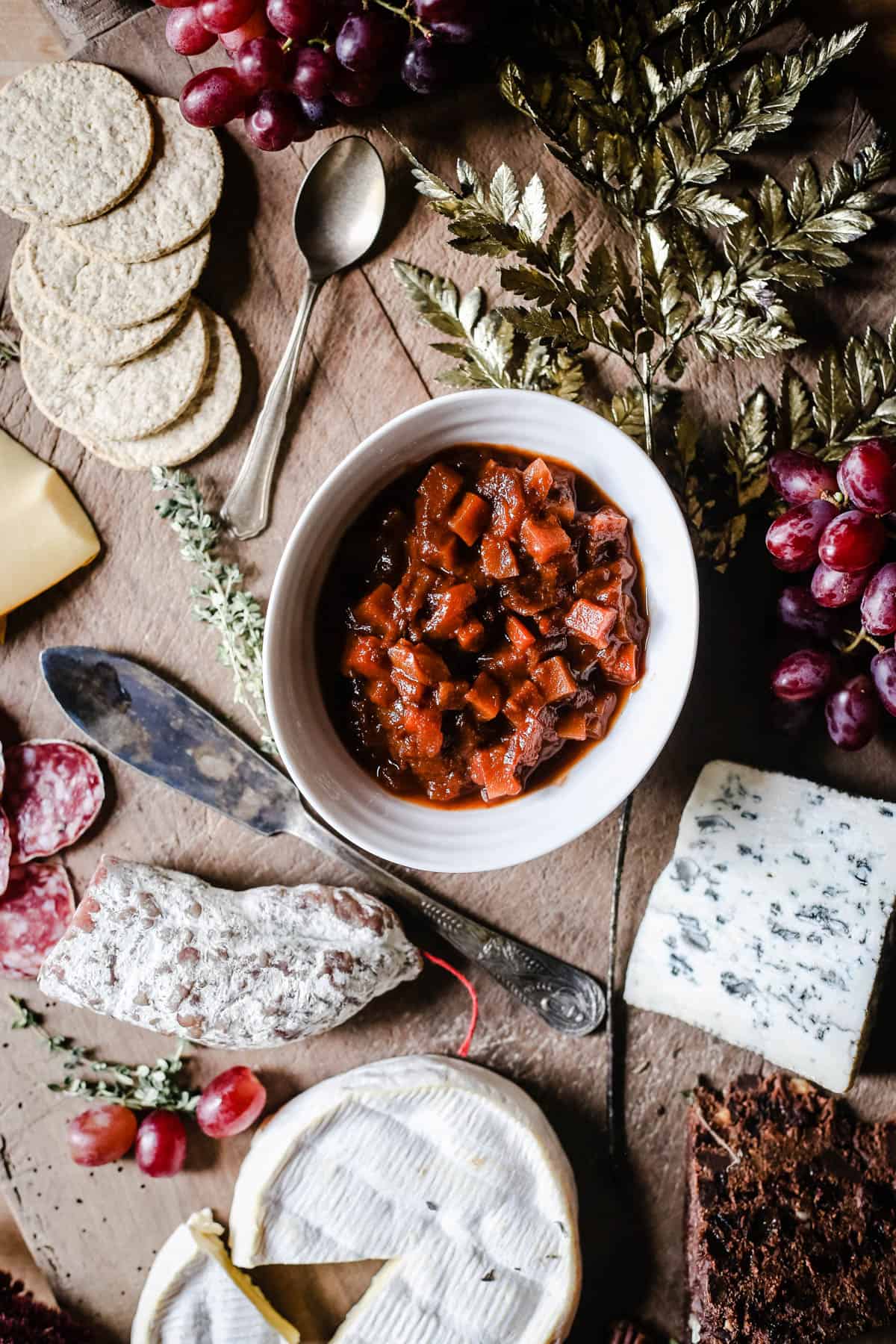
FAQs
If your chutney is still too runny after the time given in the recipe then you can just cook for a little longer. You want the chutney to be thick with a little sauce but not too liquidy. Spoon the sauce onto a plate to test. You know the sauce is ready when you can run a spoon down the juices without it coming straight back together.
The strong flavours of this chutney mean you can lean into a robust ale. Dark ale is perfect. Different brands are so varied that I recommend buying a few to try to flavour match. You want the flavour of your ale to be rich, malty and fruity. Some bitters might work well (for example I used Chiltern Brewery’s Birchwood Best Bitter). However, since you are looking for a gluten-free ale then you might be limited by choice. If you can only find pale ale then don’t worry it works just fine – it’s just a lighter flavour.
The ingredients in this recipe have been carefully balanced so that you don’t need to can this recipe. This means the levels are 60-65% fruit + veg, 30-35% sugar and 15-20% vinegar.
The correct safety standards for this chutney are as follows:
You used sterilised jars and lids (see tips above).
The chutney was poured into the jars hot and sealed immediately.
The jars were cooled down slowly and undisturbed at room temperature (12-24 hours). As the jars cool a vacuum should be created in the jars which you can check by pressing the lid down, it shouldn’t move. If it moves down and pops then the vacuum hasn’t been created and you need to store that jar in the fridge.
If safety standards have been adhered to throughout the recipe and you have used sterilised jars and lids then the chutney should keep for at least 12 months if stored in a cool dry and dark place. Don’t store outside as cold surfaces or draughts can cause condensation and potential moisture which can lead to mould.
Once the jar has been opened then you need to keep in the refrigerator and use within 2 weeks.
If the lid from the chutney jar has popped after months in your larder that means that there is no longer a vacuum and air can get into the jar. This can happen during long term storage and it’s best to discard these jars at this point.
If mould has appeared in the chutney then you must discard the whole jar. Scraping the mould off the top won’t cut it as mould has long invisible tendrils which will have travelled down the jar, the whole jar has been spoiled at this point.
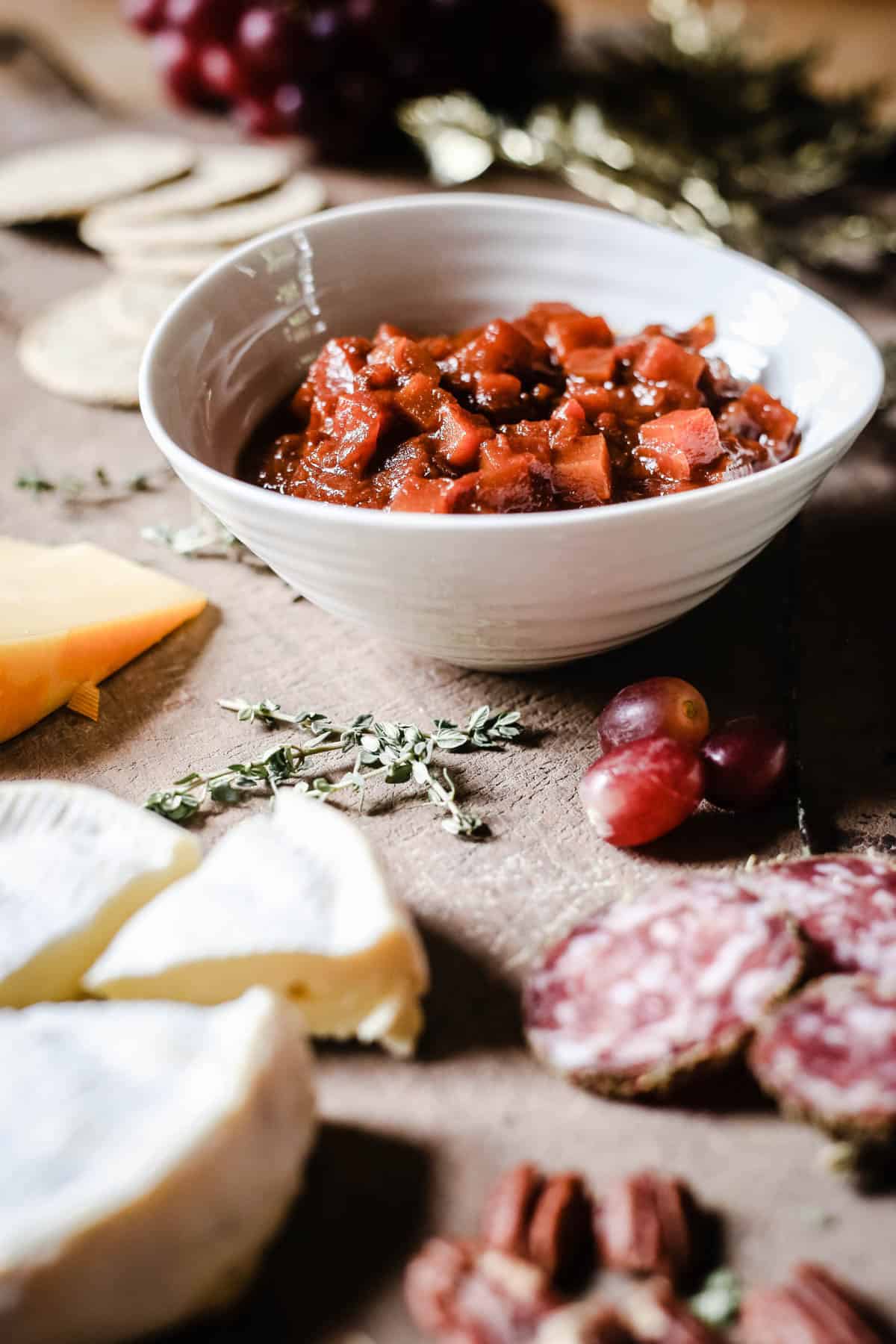
Serving Suggestions
This Ale Chutney works deliciously with this Glazed Christmas Ham, leftover turkey, pork pies, sandwiches and festive canapés.
It’s the perfect accompaniment to your cheese or charcuterie board.
Pair this Christmas Ale Chutney with British cheeses like really good Cheddar, Double Gloucester, Stilton or Wensleydale.
Serve the ale chutney alongside the cheese and cold meats with these Seeded Crispbreads, with oatcakes or even sweet digestives.

A Very Merry Gluten-Free Christmas
Your comprehenseive guide to celebrating a Gluten-Free Christmas. With 45+ Christmas recipes, timings for the day and tips on hosting and food preparation.
More Chutneys You’ll Love
If you are faced with a glut of plums then you will not regret turning your load into this delicious Plum and Beetroot Chutney. Gently spiced and gorgeously smooth with a few tender bites of seasonal beetroot. Perfect for sandwiches and lovely with cold cuts, quiche, sausage rolls or cheese.
This Easy Homemade Apple Ginger Chutney is a quick and easy sweet slightly spiced chutney. It’s perfect with cheese, on crackers, with pork pies or served up with cold meats to accompany a buffet table.
Piccalilli is delicious spicy British pickle. Bite-sized pieces of Autumn vegetables fragrant with curry spices which is excellent with any kind of cheese or cold cut.
Enter your email below to get this recipe sent to your inbox plus get new recipes, baking tips, and updates.
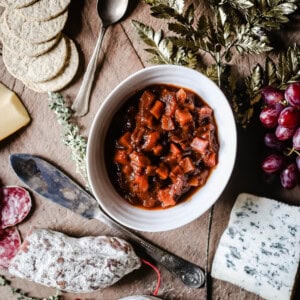
Christmas Ale Chutney
Ingredients
- 400 g Bramley apples - about 2
- 200 g Granny Smith apples - about 2
- 400 g red onions - about 3
- 200 g carrots - about 2
- 200 g parsnips - about 2
- 150 g prunes
- 150 g dates - pitted
- 575 g light soft brown sugar
- 80 g black treacle
- 320 g apple cider vinegar
- 2 garlic cloves - peeled and diced
- 30 g fresh ginger - peeled and diced
- 1 tablespoon mustard powder
- 1 tablespoon Worcestershire sauce
- ½ orange - zested
- 1 teaspoon nutmeg
- 1 teaspoon ground cinnamon
- ½ ground allspice
- ½ teaspoon salt
- ¼ teaspoon ground black pepper
- 500 ml gluten-free ale
Instructions
- First peel and chop the vegetables into even 1.5cm sized cubes, always end with the apples so they don’t brown before you start making the chutney.
- Put all ingredients into a large preserving pot with 150ml water and half of the ale.
- Bring to a gentle simmer, stirring occasionally, and cook for an hour.
- Pour in the rest of the ale and stir in.
- Cook the chutney for a further 30 minutes until thickened with little saucy liquid.
- Remove from the heat and decant into sterilised jars.
- Store in a cool dark place until ready to serve. Once the jars are opened the chutney should be kept refrigerated.


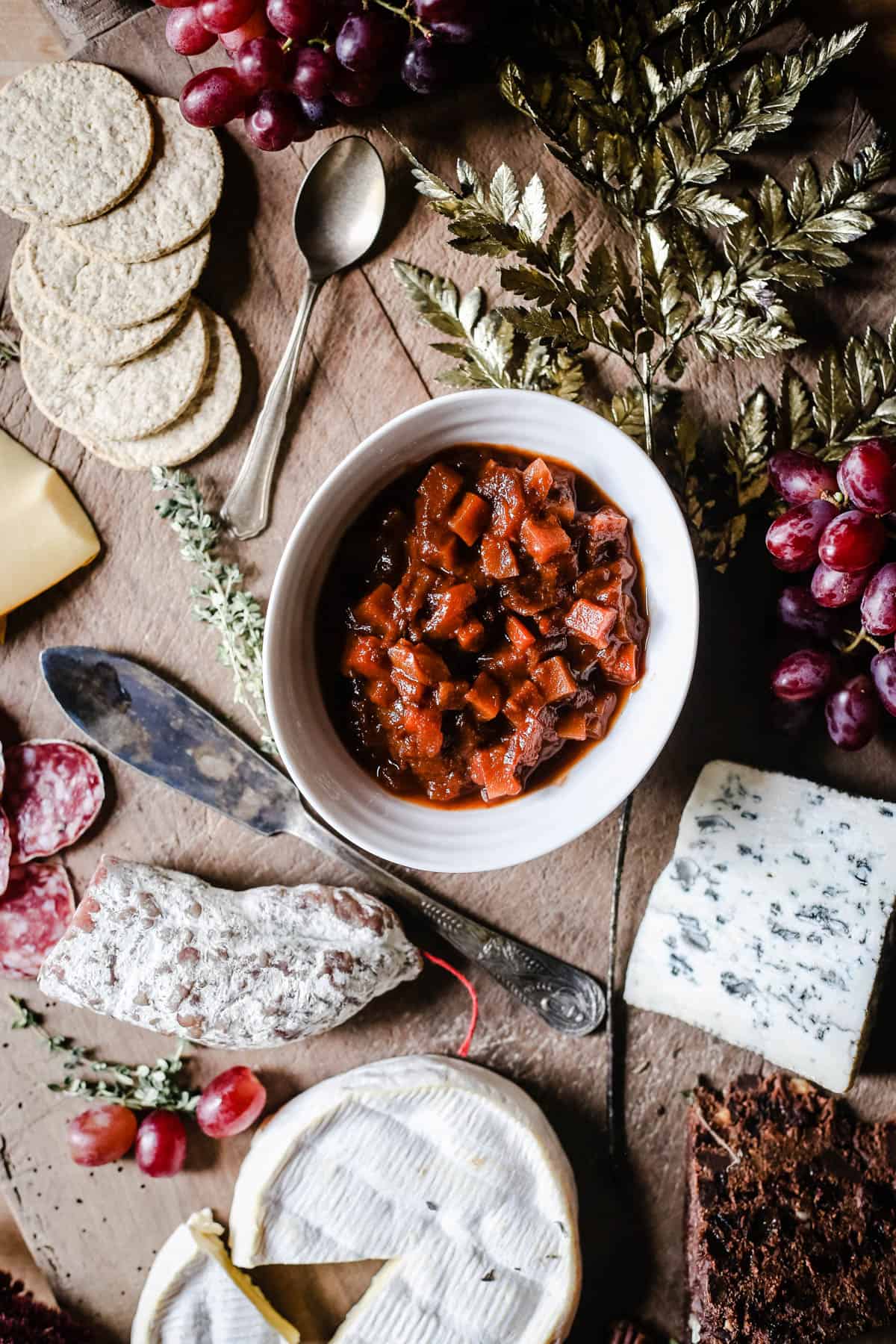

I followed this Boxing Day Ale recipe to the letter and I’m disappointed that it has a bitter, back of the throat ‘hit’ when you taste it. Is this something that mellows after storing for a month or so. Can you shed any light as to what has caused?
All chutneys mellow after a time. Ideally make your chutneys about 6 weeks prior to when you want to eat it.
Does the ale need to be gluten free specifically as I can’t find any in the supermarkets?
Only if you need to cater for gluten-free then otherwise no.